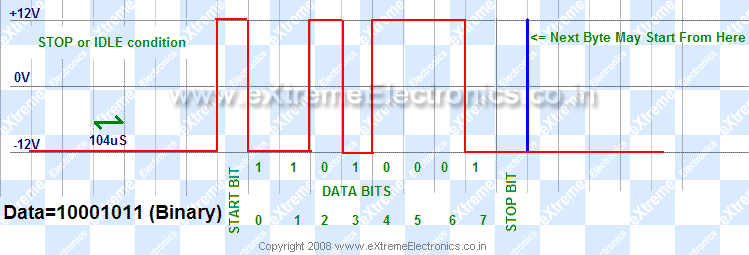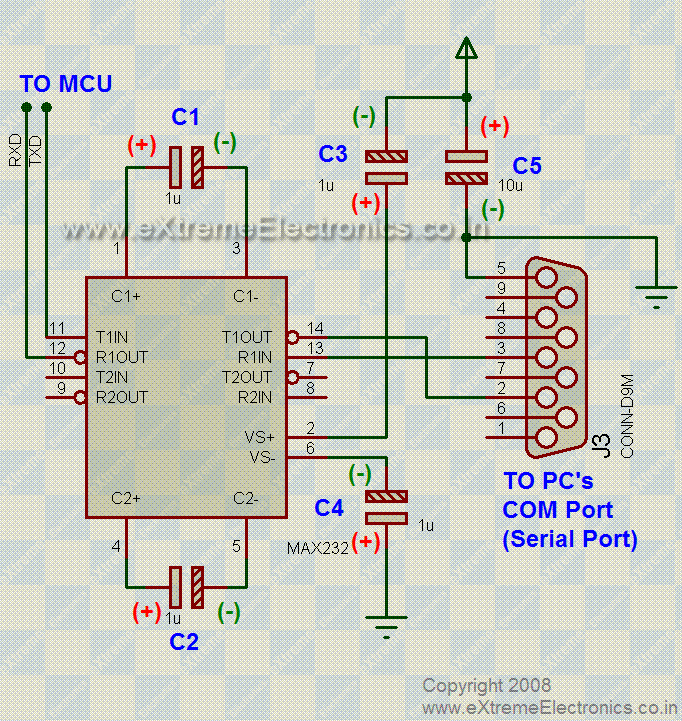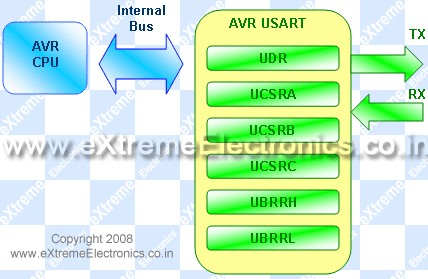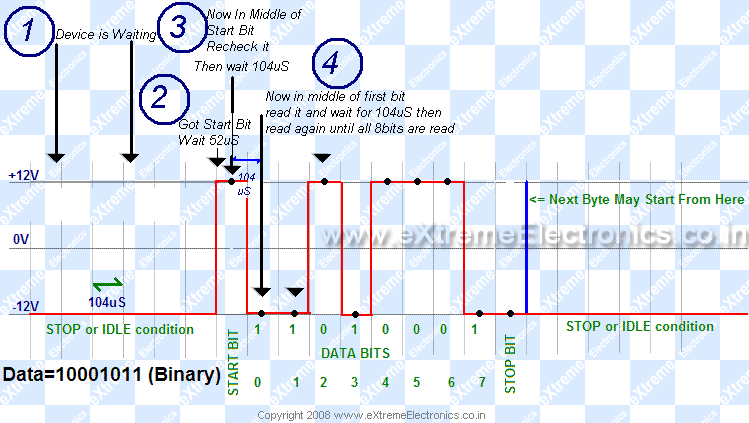RS232 is a asynchronous serial communication protocol widely used in computers and digital systems. It is called asynchronous because there is no separate synchronizing clock signal as there are in other serial protocols like SPI and I2C. The protocol is such that it automatically synchronize itself. We can use RS232 to easily create a data link between our MCU based projects and standard PC.
In serial communication the whole data unit, say a byte is transmitted one bit at a time. While in parallel transmission the whole data unit, say a byte (8bits) are transmitted at once. Obviously serial transmission requires a single wire while parallel transfer requires as many wires as there are in our data unit. So parallel transfer is used to transfer data within short range (e.g. inside the computer between graphic card and CPU) while serial transfer is preferable in long range.
As in serial transmission only one wire is used for data transfer. Its logic level changes according to bit being transmitted (0 or 1). But a serial communication need some way of synchronization.
As there is no "clock" line so for synchronization accurate timing is required so transmissions are carried out with certain standard speeds. The speeds are measured in bits per second. Number of bits transmitted is also known as baud rate. Some standard baud rates are 1200,2400,4800,9600,19200,etc.
For our example for discussion of protocol we chose the speed as 9600bps(bits per second). As we are sending 9600 bits per second one bits takes 1/9600 seconds or 0.000104 sec or 104 uS (microsecond= 10^-6 sec).
To transmit a single byte we need to extra bits they are START BIT AND STOP BIT.Thus to send a byte a total of ten bits are required so we are sending 960 bytes per second.
Transmission
- When there is no transmission the TX line sits HIGH ( STOP CONDITION )
- When the device needs to send data it pulls the TX line low for 104uS (This is the start bit which is always 0)
- It sends each bit with duration = 104uS
- Finally it sets TX lines to HIGH for at least 104uS (This is stop bits and is always 1). "At least" because after you send the stop bit you can either start new transmission by sending a start bit or you let the TX line remain HIGH till next transmission begin in this case the last bit is more than 104uS.

Reception
- The receiving device is waiting for the start bit i.e. the RX line to go LOW.
- When it gets start bit it waits for half bit time i.e. 104/2 = 51uS now it is in middle of start bit it reads it again to make sure it is a valid start bit not a spike.
- Then it waits for 104uS and now it is in middle of first bit it now reads the value of RX line.
- In same way it reads all 8 bits
- Now the receiver has the data.
Level Conversion:
What a level converter will do is to convert RS232 level signals (HIGH=-12V LOW=+12V) from PC to TTL level signal (HIGH=+5V LOW=0V) to be fed to MCU and also the opposite.
As RS232 is such a common protocol there is a dedicated IC designed for this purpose of "Level Conversion". This IC is MAX232 from Maxim. By using charge pumps it generates high voltages(12V) and negative voltages(-12V).

USART of AVR Microcontrollers:
Like many microcontrollers AVR also has a dedicated hardware for serial communication this part is called the USART – Universal Synchronous Asynchronous Receiver Transmitter.You just have to supply the data you need to transmit and it will do the rest. As you saw serial communication occurs at standard speeds of 9600,19200 bps etc and this speeds are slow compared to the AVR CPUs speed. The advantage of hardware USART is that you just need to write the data to one of the registers of USART and your done, you are free to do other things while USART is transmitting the byte.
USART automatically senses the start of transmission of RX line and then inputs the whole byte and when it has the byte it informs you(CPU) to read that data from one of its registers.
The USART of the AVR is connected to the CPU by the following six registers.
- UDR – USART Data Register : Actually this is not one but two register but when you read it you will get the data stored in receive buffer and when you write data to it goes into the transmitters buffer.
- UCSRA – USART Control and status Register A : As the name suggests it is used to configure the USART and it also stores some status about the USART. There are two more of this kind the UCSRB and UCSRC.
- UBRRH and UBRRH : This is the USART Baud rate register, it is 16BIT wide so UBRRH is the High Byte and UBRRL is Low byte. But as we are using C language it is directly available as UBRR and compiler manages the 16BIT access.
So the connection of AVR and its internal USART can be visualized as follows.
 |
Before using the USART it must be initialized properly according to need. Having the knowledge of RS232 communication and Internal USART of AVR you can do that easily. We will create a function that will initialize the USART for us.
#include <avr/io.h>
#include <inttypes.h>
void USARTInit(uint16_t ubrr_value)
{
//Set Baud rate
UBRR= ubrr_value;
/*Set Frame Format
>> Asynchronous mode
>> No Parity
>> 1 StopBit
>> char size 8
*/
UCSRC=(1<<URSEL)|(3<<UCSZ0);
//Enable The receiver and transmitter
UCSRB=(1<<RXEN)|(1<<TXEN);
}
After this procedure is done, we can send and receive data from the microcontroller via RS232 protocol.

No comments:
Post a Comment